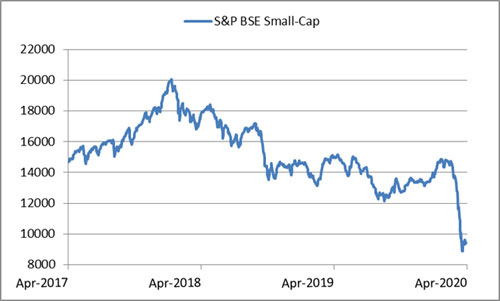Multiple Small Cap Funds Open their Investment Window, Is it Worth Taking the Risk?
Listen to Multiple Small Cap Funds Open their Investment Window, Is it Worth Taking the Risk?
00:00
00:00
The last couple of years have been very difficult for investors in the small cap space. After the euphoric rally of 2017, small caps started correcting sharply since January 2018 onwards.
Rejig in mutual fund categorisation norms, weak macro indicators, liquidity crisis in NBFC sector were some of the factors that caused sharp volatility in the segment.
In the current year, any hopes of recovery from the segment in the foreseeable future were dashed after the outbreak of coronavirus induced equity global sell-off.
Consequently, S&P BSE Smallcap index cracked over 50% from its peak in January 2018 and over 30% since March 2020 till date when the virus cases started rising in India.
Many small cap funds have generated negative returns in the past couple of years.
Graph: Small caps have been battered since the last couple of years
 Data as on April 3, 2020
Data as on April 3, 2020
(Source: ACE MF)
But on the brighter side, the sharp correction in prices has made valuations in the segment attractive.
[Read: Bears Run Loose. But Here Is Why Mid and Small Caps May See the Best Recovery]
In the wake of this, some mutual funds have decided to restart accepting lump sum investments into their respective small cap funds.
DSP Smallcap Fund, SBI Smallcap Fund, and Nippon Smallcap Fund are the schemes in which you can now make lump sum investments. Since the past few years, these schemes were only accepting investments through the systematic plan route.
Until few years back, small cap funds were generating very strong returns and money started flowing into these funds. Therefore, the corpus of many small cap funds started ballooning. This coupled with high valuations and lack of buying opportunities posed difficulties in managing the fund and restricted its ability to generate returns.
To tackle this problem many fund houses restricted fresh entry into their small cap funds.
Now, since the current situation provides attractive buying opportunities with a better margin of safety, fund houses have decided to remove the temporary restriction they had imposed.
SBI Smallcap Fund and DSP Smallcap Fund reopened lump sum subscriptions from March 30 and April 01, respectively. Nippon Smallcap Fund started accepting lump sum subscription from April 3. Other fund houses may follow suit.
Should you invest in small cap funds now?
It is difficult to predict the bottom even for seasoned investors. The pandemic of coronavirus has hit businesses hard. While large caps may be in a better position to absorb this shock, small caps may not fare well. Since there is no cure yet for the pandemic and the infection rate is rising steadily, there may be more volatility in store for the equity market.
[Read: What Could Be the Potential Impact of a Lockdown on Your Mutual Fund Portfolio? Know Here...]
Small caps have the potential to generate very high return, though the risk involved is high as well -- thrilling highs may be followed by dangerous lows. Even though many small caps have corrected sharply only a few quality stocks having strong balance sheet, low debt, and sustainable business models in the segment will witness substantial recovery.
Graph: Top performing small cap fund outpaced index with a remarkable margin
 *YTD as on April 3, 2020
*YTD as on April 3, 2020
(Source: ACE MF, PersonalFN Research)
Thus, committing a lump sum amount in small caps can be risky. If you want to invest in small cap funds, opt for the systematic investment route instead to lower the risk of volatility and benefit from averaging of investment cost.
Furthermore, since there is a fear of global recession looming, we cannot expect a sharp recovery in the near term. So if you want to invest, do so only if you have the patience to handle volatility and an investment horizon of more than five years.
The proportion of small cap fund holding in your portfolio should be based on your risk appetite. Do not take undue risk in the hopes of high returns. The balance can be diversified across large cap funds, multicap funds, mid cap funds, large & mid cap funds, value style funds, and aggressive hybrid funds based on your personalised asset allocation plan.
Invest in worthy mutual funds that focus on picking quality stocks at reasonable valuations and have efficient risk-management system in place. The fund should be able to contain the downside during market downturns and perform better during market rallies as compared to the benchmark and peers across most time frames.
At PersonalFN, we select and recommend mutual funds on quantitative and qualitative parameters using our S.M.A.R.T Score Matrix:
-
S - Systems and Processes
-
M - Market Cycle Performance
-
A - Asset Management Style
-
R - Risk-Reward Ratios
-
T - Performance Track Record
If you wish to select worthy mutual fund schemes, I recommend you to subscribe to PersonalFN's unbiased premium research service, FundSelect.
Additionally, as a bonus, you get access to PersonalFN's popular debt mutual fund service, DebtSelect.
Each fund recommended under FundSelect goes through our stringent process, where they are tested on both quantitative as well as qualitative parameters.
Every month, PersonalFN's FundSelect service will provide you with insightful and practical guidance on equity mutual funds and debt schemes - the ones to Buy, Hold, or Sell.
If you are serious about investing in a rewarding mutual fund scheme, Subscribe now!
Warm Regards,
Divya Grover
Research Analyst
Join Now: PersonalFN is now on Telegram. Join FREE Today to get ‘Daily Wealth Letter’ and Exclusive Updates on Mutual Funds